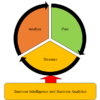The management world is awash with stories about the magic of analytics including more recently, the Internet of Things and artificial intelligence.
Harvard Business Review, the McKinsey Quarterly, Sloan Management Review, The Economist and several other respected journals provide regular examples of companies that use analytics to achieve better results. But the process by which these results are achieved is not typically discussed.
This research project, a survey of 417 organizations in North America, China and Japan, was launched to address the question of how the use of analytics influences business results.
The key takeaway is that to extract maximum value from the combination of tools referred to as business intelligence (BI) or business Analytics (BA), companies should consider their decision-making environments.
If the objective is to reduce decision-making uncertainty, they should focus more on BI. On the other hand, if decisions are being made under conditions of high ambiguity, the focus should be on more advanced analytic tools.
The research
Three industry partners participated in the study: Philip Townsend and Stuart Smith from PwC as well as Kevin Wennekes from the Canadian Advanced Technology Alliance.
The online survey received 417 completed responses on a wide range of questions about performance management and the use of analytics in the participating organizations.
The research paper was written by a group of scholars from Ottawa as well as Melbourne in Australia, Ningbo in China and Ljubljana in Slovenia.
Study framework
We first considered the outcome of the effective use of analytics. As mentioned above, many of the articles discussing the value of analytics make a direct link between the use of analytics and business results. This study suggests that analytic techniques provide information that leads to more effective business processes. Process improvement at all levels in the organization drives better business results.
The complication here was that the term “analytics” means many different things. For some, a dashboard is a form of analytics; for others, analytics means the use of sophisticated statistical techniques such as machine learning and artificial intelligence algorithms. We therefore had to distinguish between BI and BA tools and methods.
We defined BI as a set of technologies for processing information and BA as advanced analytic techniques that make use of BI-delivered information. Nowadays, BA tools are being included in BI so the field is becoming less delineated. But realistically speaking, all organizations now have information systems that process data and technologies for conducting analytics.

Because our focus was on how analytics informed management practices that eventually influenced process improvement, we defined a management cycle that includes planning, measurement and analysis as shown in the figure above.
Lessons learned
-
A one-unit increase in BI effectiveness would improve the use of analytics by about 60%.
-
A one-unit increase in the effectiveness of BI and BA combined would improve measurement effectiveness by about 50%.
-
A one-unit increase in measurement effectiveness would improve processes by 46%.
-
A one-unit increase in BI effectiveness would increase processes by about 46%. A similar increase in BA effectiveness would have an impact of about 20%.
Implication for managers
Item 4 above raises questions about the role and influence of BI versus BA.
Based on Information Processing Theory, our interpretation is that the decision environment determines the types of technologies that deliver the most value to organizations.
Under decision-making conditions of high uncertainty, organizations need more information and so BI is likely to have a bigger impact. Under conditions of high ambiguity, however, more information will not necessarily help. In this case, well-developed analytic routines coupled with high human involvement to explore options will make a difference.
Every study has its limitations therefore these results are not cast in stone, but they do provide food for thought about how to best extract value from analytics. Our research continues to further validate these findings and to explore differences between small and large organizations as well as the socio-technical implications of advanced analytics such as artificial intelligence.


